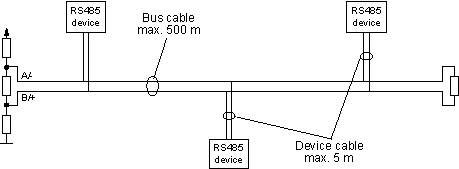

- RS 485 VOLTAGE LEVEL SERIAL
- RS 485 VOLTAGE LEVEL SOFTWARE
- RS 485 VOLTAGE LEVEL CODE
- RS 485 VOLTAGE LEVEL SERIES
This series of handshake controls was devised to allow the DTE to request control of the communications link from the related modem, and then to let the modem inform the terminal equipment that the control has been acquired.

This is normally one bit long and is used to signify the end of a particular byte.

Unlike many systems these days there is no facility for error correction.įinally a stop bit is sent. This is used to check the correctness of the received data and it can indicate whether the data has an odd or even number of logic ones. Again this requires setting because it is optional and it can be even or odd parity.
RS 485 VOLTAGE LEVEL CODE
However other codes including the Murray Code or EBCDIC (Extended Binary Coded Decimal Interchange Code) can be used equally well.Īfter the data itself a parity bit is sent. The receiver obviously has to know how many data bits to expect, and there are often small dual in line switches either on the back of the equipment or inside it to set this information.ĭata on RS232 is normally sent using ASCII (American Standard Code for Information Interchange). This is followed by the data itself and there are normally seven or eight bits. To achieve this a logic 0 is sent as a start bit for the synchronisation. This mode of data transmission also requires that the receiver knows when the actual data bits are arriving so that it can synchronise itself to the incoming data. The data is sent serially on RS232, each bit is sent one after the next because there is only one data line in each direction.

It is also necessary to define the voltage states for the control signals as these are widely used within RS 232. The two states are defined as in the table below. In order that the RS 232 transmitters and receivers can be designed to a common standard, it is necessary to define the voltage levels that constitute the two logical states required for data transmission. If the lines fall outside the required limits, then there can be uncertainty and data errors. If the voltages fall within the defined levels, then the receivers are able to correctly detect the data that is being transmitted, or the state of the other lines. In this way any RS232 system can be assured of its correct operation. The RS232 standards include defined levels for the lines along with a mode of operation for the handshaking.
RS 485 VOLTAGE LEVEL SERIAL
Serial Data standards: Serial data standards RS422 RS449 RS485 20 mA current loop
RS 485 VOLTAGE LEVEL SOFTWARE
RS232 basics RS232 standard Software handshaking Signals & voltage levels Pinouts & connectors Loopback connections RS232 cables RS232 Voltage Levels & Signals: DTR, CTS, RTS RS232 voltage levels are defined along with the handshaking requirements for lines including DTR, CTS, RTS.


 0 kommentar(er)
0 kommentar(er)
